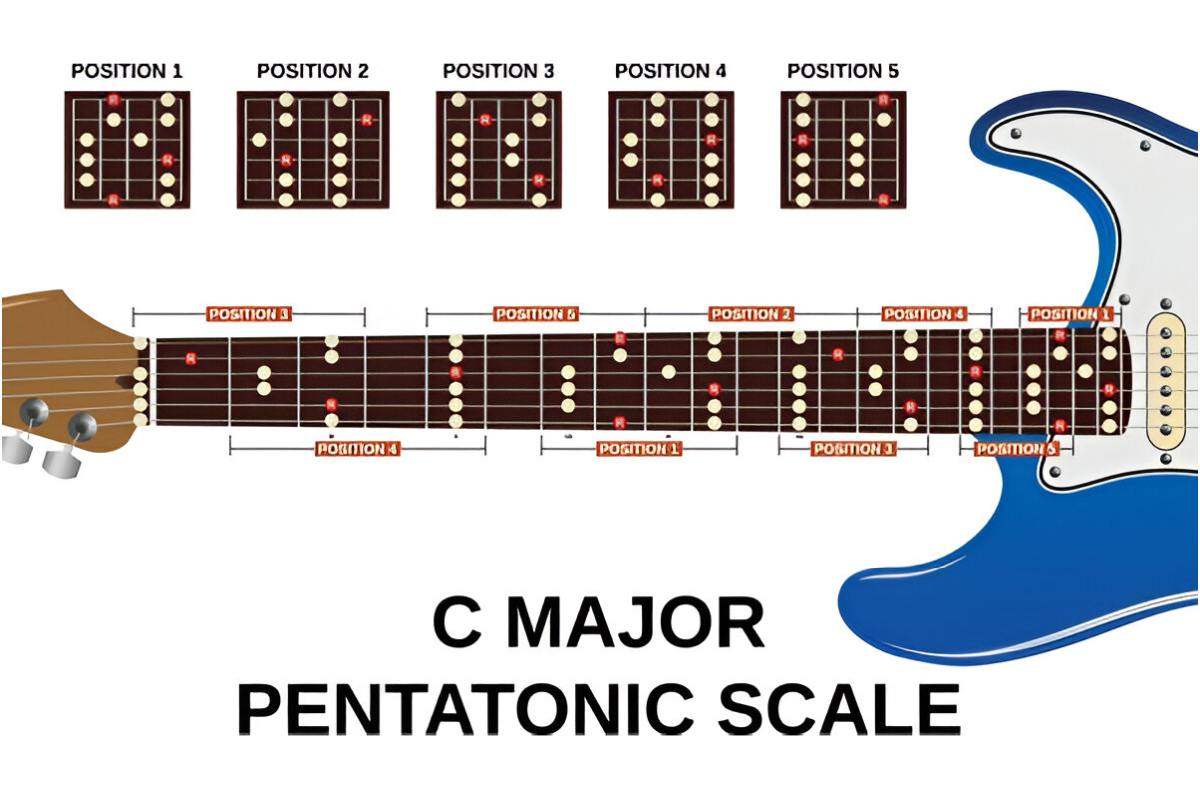Taylor Swift is renowned for writing chart-topping songs with catchy melodies and relatable lyrics. A lot of them also have basic structures, which makes them some of the best songs for guitar beginners to learn.
That’s why I decided to take a closer look at three of Taylor’s most popular guitar songs and teach you exactly how to play them. I’ll include the chords and strumming patterns for each section, plus other tips that will ensure they sound the same as when Taylor plays them.
All you’ll need to know are your standard root chords - A, Am, C, D, Em, and G. I’ll also introduce you to some simple yet interesting chordal variations that Taylor uses in these and a lot of her other songs.
Strumming Patterns
Before we get started, I’ll just go through how to read the strumming patterns.
You can split a 4 beat bar up into four main beats - 1, 2, 3, 4. These can either be played as a downstroke (D) an upstroke (U), or not played at all (rest). Therefore, a bar that contains 4 downbeats would be - D D D D. And a bar that contains a downbeat followed by an upbeat, then another downbeat, followed by another upbeat would look like this - D U D U.
We can also add additional beats in between the four main beats, therefore the 4-beat bar would now be 1 + 2 + 3 + 4 + (1 and 2 and 3 and 4 and). The additional strums can either be a downstroke (d), an upstroke (u), or a rest ( ). Therefore a bar that contains 4 downstrokes on the beat followed by an upstroke halfway between each beat would look like this:
1 + 2 + 3 + 4 +
D u D u D u D u
This might sound a little complicated, but you’ll soon get the hang of it. Plus, don’t worry, I’ll try and simplify the rhythms as much as possible but still make them sound like the song.
And on the subject of songs, let’s get straight to the first one…
We Are Never Ever Getting Back Together
Chords: C, G, D, Em
Let’s start with one of Taylor’s fun breakup songs.
Intro
C - G - D - Em
This song starts with a quirky rhythm, so I suggest just strumming each chord once on the first beat of the bar for now, we’ll get the rhythm going as the chorus starts.
Taylor plays a Cadd9 instead of a standard C chord and a Dsus4 instead of the D during the song, as well as in a lot of her other songs. They are not difficult chords to play, Cadd9 is a similar shape to a G chord but the first two fingers are down a string. Dsus4 is the same as a D chord but you also put your little finger on the third fret of the high E string. Playing it with these two chords makes the change between them very easy because the third and fourth fingers remain in position, as can be seen in the following diagrams:
But if you haven't learned these chords yet, don’t worry, playing the song with standard C and D chords will sound fine, then you can play it with the more complex chord versions after you get the hang of it.


Verse
C - G - D - Em
Single strums for the first verse, then for the other verses, you can use this rhythm pattern or a combination of both:
D D DuD
Chorus
C - G - D - Em/D
Rhythm
D D D Du D D D Du
D D D Du D DuD Du
Our Song
Chords: D, Em, G, A
Next, we have one of Taylor’s fun, upbeat tracks that again feature a simple chord progression that is played throughout the verse and the chorus.
Intro and Verse
D / Em - G / A - D / Em - G / A
The intro and verse have a jumpy feel, which will take quite a lot of practice to get right. The easiest way to make it sound similar to the original is to play the first two beats quite loudly, and then play the down-up-down strums a little quieter. The rhythm is the same as the one we used in the previous song, so you should be able to play it well by now.
D D DuD
There ‘ / ’ that is shown between two chords, i.e. ‘D / Em’ means that both chords are within the same bar. The ‘D D DuD’ rhythm is played for each chord, therefore, you need to play the rhythm twice in each bar.
Chorus 1
D / Em - G / A - D / Em - G / A
D / Em - G / A - G - A
Em - G (stop on the first beat of the bar and let the G ring)
This looks simple, but be careful when you come to the final four chords. Start the chorus by playing the standard chord progression, D - Em - G - A, three times using the same strumming pattern as used in the verse, then a full bar of G (not half a bar, as before) using all downstrokes, then the same for A, then again for Em, before strumming a G chord once and letting it ring to end the chorus.
This can be quite confusing for those new to the guitar because it’s natural to get into the rhythm of the song, but then, all of a sudden, you have to play the chords for twice the amount of time you’ve been playing them before. This all comes down to practice, so if you’re having difficulties with it, slow it right down and concentrate on playing it perfectly at a speed you can manage, then, over time, increase the speed until you can play along with the song.
Chorus 2
D / Em - G / A - D / Em - G / A
D / Em - G / A - G - A
Em / D - G / A
Use the same strumming pattern as you used in the verse for the chorus, but play it at a slightly higher volume. As your guitar playing improves you can vary it by palm muting the strings during the verse and playing the chords open during the chorus
Interlude with Violin and Guitar Solo
D / Em - G / A - D / Em - G / A - A
Just to confuse things a little, Taylor adds half a bar of A (2 additional beats) before her singing starts again, going into the…
Post Second Chorus Bridge
Em - G - D / A - Em
G
Chorus 3
D / Em - G / A - D / Em - G / A
D / Em - G / A - G - A
Em / D - G /A
D / Em - G / A - D / Em - G / A
D / Em - G / A
Outro
D / Em - G / A
D / Em - G (stop on the first beat of the bar and let the G ring)
You Belong with Me
Chords: G, D, Em, C
In order to play the song along with the video or a stream, you’ll need to tune your guitar down a semi-tone. This means that, instead of the strings being tuned to - E, A, D, G, B, e, you need to tune them to Eb, Ab, Db, Gb, Bb, and eb.
Most tuners and tuning apps have this function, if not, tune the notes on the first fret to E, A, D, G, B, e. To do this, place a finger on the first fret of the low E string and tune it to E. After you remove your finger, the note will be Eb.
Many artists used dropped tunings because they either prefer the way it makes the songs sound or because it matches their voices better, letting them sing higher notes.
Intro
G - G
Play two bars of G until the singing starts
This is also played at the start of each of the verses.
Verse
G - G - D - D
Am - Am - C - C
The easiest way to make this sound like the song is by playing a downstroke on each of the four beats of the bar as well as on the beats in between, ie:
D d D d D d D d
Even though this is quite simple, due to the fast tempo of the song, you may need to keep practicing it to get it up to speed. If you’re having problems playing it fast enough, simplify it by playing a downbeat and forget about the additional strums for now, you can always add them as you improve.
If you’ve already learned how to palm mute, you can also include that. But that might be asking a little too much at this stage, but again, no problem, simply add it after you’ve learned the technique.
Bridge
Am - C - G - D
Am - C - D (stop on the first beat of the bar and let the D ring)
During the bridge, every chord is only played for one bar, not two as in the verse.
1st Chorus
G - G - D - D
Am - Am - C (stop on the first beat of the bar and let the C ring)
2nd Chorus
G - G - D - D
Am - Am - C - C
G - G - D - D
Am - Am - C - C
The chorus contains the same chords, in the same order, as the verse, but the rhythm is different. The following rhythm isn’t exactly what’s played on the record but it's good enough for now, and you know it well, it’s the same one we used in the other two songs.
D D DuD
As your guitar playing improves, change the strumming pattern to be exactly the same as the one played on the song.
Guitar Solo
G - G - D - D
Am - Am - C - C
Wrapping it Up
That’s it for my look at 3 of Taylor Swift's simplest songs for guitar. Once you get the hang of playing these well, try a few more of her songs, although they’ll be harder than these three, they should still be quite easy to play. The chords she plays are generally simple but the clever songwriting often makes the structures of the songs a little confusing, as we’ve seen in the ones I’ve covered.
The secret to mastering these as well as any artists' songs is to play along with them on YouTube, Spotify, or wherever you stream your music. This is by far the best way to improve quickly, plus it’s a lot more fun than practicing a song without the music.
If you like this article, please share it!
Be sure to join our FB Group Guyker Guitar Parts VIP Group to share your ideas! You can also have connections with like-minded guitar players, Guyker updates as well as discounts information from our FB Group.








